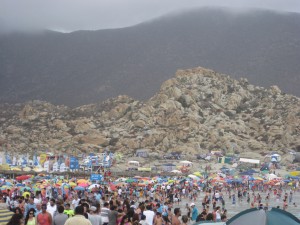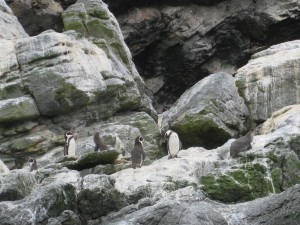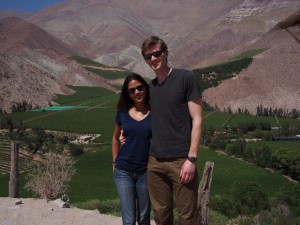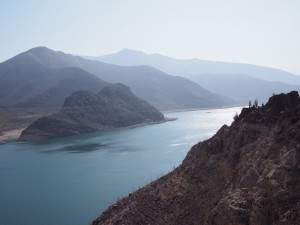The first week of our Chilean adventure brought us from Santiago to the Atacama Desert, in the extreme north. On the way, we spent four nights in La Serena, a small coastal town seven hours north of the capital.
Naturally, we took advantage of the beaches in the area. Following the advice of several locals, we spent our first day at Totoralillo beach. We arrived via a colectivo (a sort of taxi/bus) that was an adventure in itself. It was a Sunday, and the bus was full of locals taking advantage of the weekend and ignoring the foggy morning, including lots of adorable kids singing along to the radio. A half hour of entertainment later, and we arrived at the incredibly crowded beach. Every Chilean family seemed to have a tent and an umbrella– and as the day went on and the tide rose, they squeezed closer and closer together.
Despite the crowds, the recommendations were spot-on. The water was crystal clear, the landscape was gorgeous, and the sand (though mostly invisible due to all of the people) was white. Although we consider ourselves pretty tough, even after the sun came out it was hard to stay in the frigid water for long. The locals somehow had no problem with it.
The following day, we headed off to one of the most famous area attractions – Isla Damas, a nature preserve accessible by boat from the fishing village Punta Choros, around two hours from La Serena. After a minor issue with a broken boat, we sped off to the islands and saw the famous Humboldt penguins (my dad’s sensible/typical comment: “Do you know who Alexander Humboldt was? You should look it up.”), cormorants, dolphins, huge menacing seagulls intent on our destruction, and sea lions. After a full day of exploring on and off the boat, we stopped for lunch in an olive grove and slept most of the way home.
Along with Isla Damas and its penguins, the area’s other famous attraction is the Elqui Valley, a gorgeous area famous for its beauty, its Pisco production (Pisco sours are everywhere in Chile) as well as its “energy”—some people believe that the air there has special properties. The locals take full advantage of this—I’ve never seen so many stores selling crystals and herbal medicines. While we didn’t exactly pick up on the energy, we did enjoy the scenery and a visit to Los Nichos, a fifth-generation artisanal Pisco distillery. We also stopped by the tiny tourist towns of Pisco Elqui and Vicuna (again, lots of crystals).
Later that night, we met up with two friends from the tours and headed via colectivo to Coquimbo, with plans to celebrate one of their birthdays with seafood, drinks and revelry. It was a challenge – at 10 pm, most of the local seafood places were closed but a lot of the dinner restaurants hadn’t yet opened. While in search of a likely looking spot, we encountered lots of friendly locals, the mayor of Coquimbo traveling with a camera crew (less friendly after discovering that we did not have Chilean roots), some kind of surreal party bus for children with costumed Disney characters, and mojitos. Really, everything one could want in a night out.





R & B – love your trip so far. I am nuts for the Atacama Desert. Did you go on farther north, like to San Pedro with its naturally dried mummies? I once saw a 360-degree sunset in the Atacama, unbelievable, and then the moon reflected off the salts in the soil and the landscape gleamed like polished silver.
Wow, I’m getting nostalgia just remembering.
Sunny here today, but really cold in DC, so am envious of your basking on the beach. Brrrr. Humboldt Current! (Von Humboldt 😉 Good for your dad, Rachel.
Love, Aunt Cathy
Aunt Cathy — Hi! We’ve actually been staying in San Pedro. It’s a fun town (but extremely dry, so no surprise about the mummies). It’s beautiful up here, but we’re looking forward to a change of scenery and a little city time– Valparaiso tomorrow. Hope all is well!
Classic coastal strategy.
Live life like a series of Catan moves?